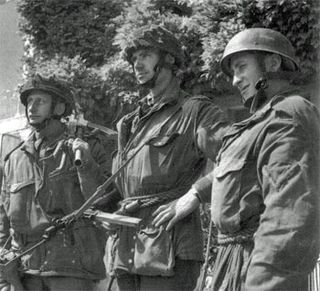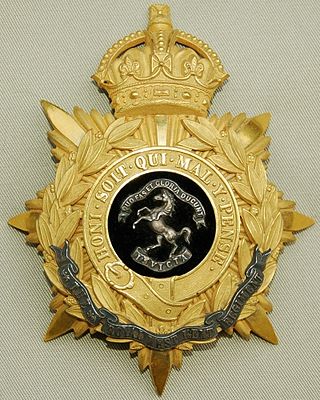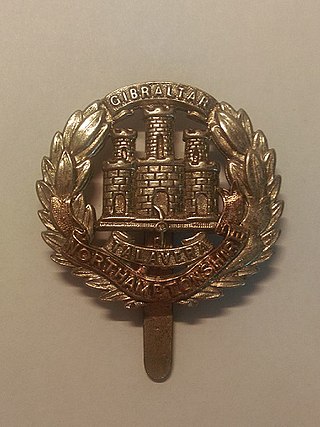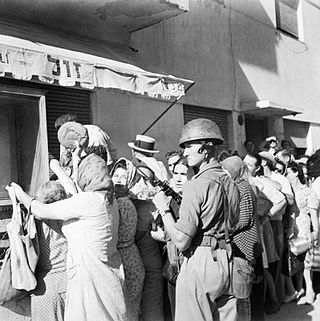Haganah was the main Zionist paramilitary organization that operated for the Yishuv in the British Mandate for Palestine. It was founded in 1920 to defend the Yishuv's presence in the region, and was formally disbanded in 1948, when it became the core force integrated into the Israel Defense Forces shortly after the Israeli Declaration of Independence.

The 6th Airborne Division was an airborne infantry division of the British Army during the Second World War. Despite its name, the 6th was actually the second of two airborne divisions raised by the British Army during the war, the other being the 1st Airborne Division. The 6th Airborne Division was formed in the Second World War, in mid-1943, and was commanded by Major-General Richard N. Gale. The division consisted of the 3rd and 5th Parachute Brigades along with the 6th Airlanding Brigade and supporting units.

The Jewish Legion was an unofficial name used to refer to five battalions of the British Army's Royal Fusiliers regiment, which consisted of Jewish volunteers recruited during World War I. In 1915, the British Army raised the Zion Mule Corps, a transportation unit of Jewish volunteers, for service in the Gallipoli campaign. Two years later in August 1917, the decision was made to raise an infantry battalion of Jewish soldiers which would be integrated into an existing British Army regiment.

The Jewish Infantry Brigade Group, more commonly known as the Jewish Brigade Group or Jewish Brigade, was a military formation of the British Army in the Second World War. It was formed in late 1944 and was recruited among Yishuv Jews from Mandatory Palestine and commanded by Anglo-Jewish officers. It served in the latter stages of the Italian Campaign, and was disbanded in 1946.

The Essex Regiment was a line infantry regiment of the British Army in existence from 1881 to 1958. The regiment served in many conflicts such as the Second Boer War and both World War I and World War II, serving with distinction in all three. It was formed in 1881 under the Childers Reforms by the amalgamation of the 44th Regiment of Foot and the 56th Regiment of Foot.

The Queen's Own Royal West Kent Regiment was a line infantry regiment of the British Army based in the county of Kent in existence from 1881 to 1961. The regiment was created on 1 July 1881 as part of the Childers Reforms, originally as the Queen's Own (Royal West Kent Regiment), by the amalgamation of the 50th (Queen's Own) Regiment of Foot and the 97th (The Earl of Ulster's) Regiment of Foot. In January 1921, the regiment was renamed the Royal West Kent Regiment (Queen's Own) and, in April of the same year, was again renamed, this time as the Queen's Own Royal West Kent Regiment.

The Notrim were Jewish auxiliaries, mainly police, set up in 1936 by the British in Mandatory Palestine during the 1936–39 Arab revolt. The British authorities maintained, financed and armed the Notrim until the end of the Mandate in 1948, even though they knew that while the force was nominally answerable to the Palestine Police Force, it was in fact controlled by the Haganah.
The 18th Infantry Brigade was an infantry brigade of the British Army that saw active service during the First and the Second World Wars.

The 132nd Infantry Brigade was an infantry brigade of the British Army that remained in British India during the First World War. During the Second World War, it served with the 44th Infantry Division in Belgium and France, later being evacuated at Dunkirk and seeing service again in North Africa at El Alamein before being disbanded in January 1943.
The 133rd Infantry Brigade was an infantry brigade of the British Army that saw service during the First World War in British India, but never as a complete formation. In the Second World War, the brigade fought in the Battle of France in May 1940 and was evacuated at Dunkirk. It later fought in the North African Campaign, and was disbanded on 1 January 1943.

The Northamptonshire Regiment was a line infantry regiment of the British Army in existence from 1881 until 1960. In 1960, it was amalgamated with the Royal Lincolnshire Regiment to form the 2nd East Anglian Regiment, which was amalgamated with the 1st East Anglian Regiment, the 3rd East Anglian Regiment and the Royal Leicestershire Regiment to form the present Royal Anglian Regiment.

The Loyal Regiment (North Lancashire) (until 1921 known as the Loyal North Lancashire Regiment) was a line infantry regiment of the British Army that was in existence from 1881 to 1970. In 1970, the regiment was amalgamated with the Lancashire Regiment to form the Queen's Lancashire Regiment which was, in 2006, amalgamated with the King's Own Royal Border Regiment and the King's Regiment (Liverpool and Manchester) to form the Duke of Lancaster Regiment (King's, Lancashire and Border).

The 6th Airborne Division in Palestine was initially posted to the region as the Imperial Strategic Reserve. It was envisioned as a mobile peace keeping force, positioned to be able to respond quickly to any area of the British Empire. In fact the division became involved in an internal security role between 1945 and 1948.
Israel (Yisrael) Carmi, born 1917, died 20 January 2008, was the founder of the Tilhas Tizig Gesheften.
The 197th Brigade was an infantry brigade formation of the British Army that saw distinguished active service in both the First and Second world wars.

The 12th (Eastern) Infantry Division was an infantry division of the British Army, which fought briefly in the Battle of France during the Second World War. In March 1939, after the re-emergence of Germany as a European power and its occupation of Czechoslovakia, the British Army increased the number of divisions within the Territorial Army by duplicating existing units. The 12th (Eastern) Infantry Division was formed in October 1939, as a second-line duplicate of the 44th Infantry Division.
Palestine Command was a British military command in Mandatory Palestine and the Emirate of Transjordan.
The 177th Brigade was an infantry brigade of the British Army that saw active service in the First World War as part of 59th Division and fought again in the Second World War, now the 177th Infantry Brigade, with the 59th (Staffordshire) Infantry Division before being disbanded in August 1944.

The 148th Infantry Brigade was an infantry brigade formation of the British Army that served in both the First and briefly in the Second World War as part of the 49th Infantry Division and disbanded after the war.












